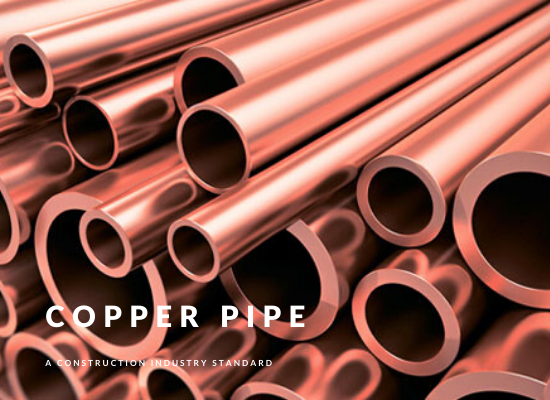Copper Pipe
Copper pipe offers an excellent way of carrying water and HVAC refrigerant throughout a building. Because it is resistant to corrosion and offers a variety of connection options, copper pipe has become a construction industry standard.
Copper Pipe Replaces Galvanized Steel
If you’ve owned a house or business building that has galvanized steel pipe, you likely know the frustrations of low water pressure. This is due to the fact that galvanized steel pipe corrodes with time and excess material builds up along the walls of the pipe. Eventually, the pipe opening is reduced by the excess material. This reduces the volume of water or refrigerant that can be carried by the pipe.
Copper pipe offers a high level of corrosion resistance. Because of this, copper pipe maintains its pipe diameter and resulting water pressure. It also doesn’t leach materials into the water.
It gradually replaced galvanized steel pipe as the choice of plumbers and HVAC pros, starting in the 1950s. By the ’70s, most new water pipe installed was made of copper.
Types of Copper Pipe
Copper pipe comes in a variety of wall thicknesses, is flexible or rigid, and can be used with soldered, roll grooved, crimped, and compression connections. Soldered connections are the long-lasting connections. Because it is rigid, elbow fittings are typically used to go around corners and change direction.
Thick-walled copper pipe is stronger and more durable than thinner types. Because of this, it is rated for higher pressure applications. The outside diameter of the pipe may vary from 3/8” to 3”. The type of pipe is clearly marked on the pipe exterior and is often color-coded. Flexible pipe is used in tight spaces or in situations where movement is expected, such as icemakers, coffee lines, and other equipment. Because it is relatively soft and thin, it can be unintentionally damaged on construction sites with something as small as a drywall screw.
Consult with your local code official for the approved types of copper pipe in your area. Some municipalities also accept PVC pipe as an alternative to copper pipe. This is in spite of PVC’s shorter lifespan (40% less) and the fact that it gets brittle over time.
Here are a few of the common types of pipe used for plumbing:
- In older houses and buildings, you may see copper pipe with a yellow marking. This is Type DWV pipe, which is only rated for low-pressure applications. It is suitable for vents, drains, and waste lines.
- Type M pipe is a thin-walled pipe that is attractive for its low price and is often used in residential projects. Type M pipe markings are often red. It is offered in flexible and rigid forms and can be installed with sweat, flare, and compression connections. The exterior dimensions of Type M and Type L pipe are identical.
- The most common form of copper pipe is Type L. It can be used for a wide variety of applications including plumbing, HVAC, and fire protection. It is thicker and more durable than type DWV and M. The thicker Type L is a good choice for areas where the water is acidic and therefore corrosive. Type L pipe marking is often blue.
- Type K pipe is thicker than Type L. Because of its thickness and resulting durability, it is used for main water lines, hot water heating, fire sprinkler systems, and applications where the pipe is buried, such as below sidewalks. Type K is available as soft (flexible) and hard (rigid). Type K pipe marking is often green.
Learn more about copper from the Copper Development Association, Inc. and see how it is installed in their series of how-to videos.




